2023年中考英语复习 第一节 题型解读课件(共65张PPT)
文档属性
| 名称 | 2023年中考英语复习 第一节 题型解读课件(共65张PPT) | 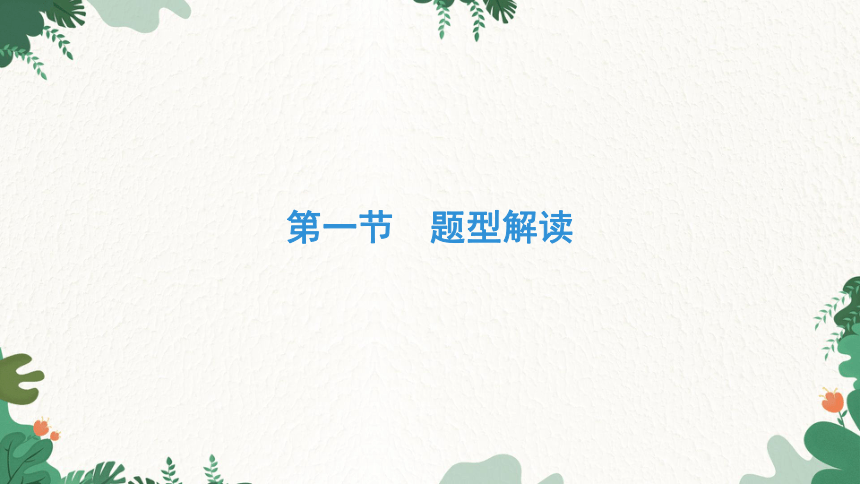 | |
| 格式 | pptx | ||
| 文件大小 | 3.1MB | ||
| 资源类型 | 教案 | ||
| 版本资源 | 外研版 | ||
| 科目 | 英语 | ||
| 更新时间 | 2023-06-11 19:46:03 | ||
图片预览

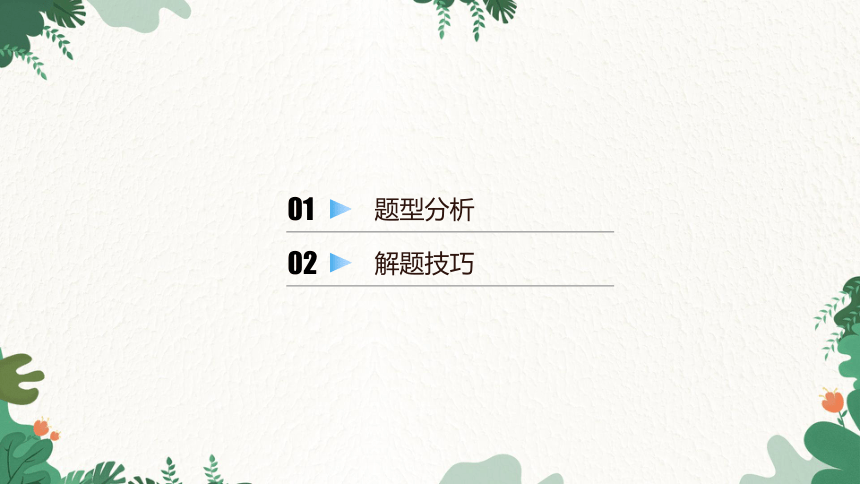
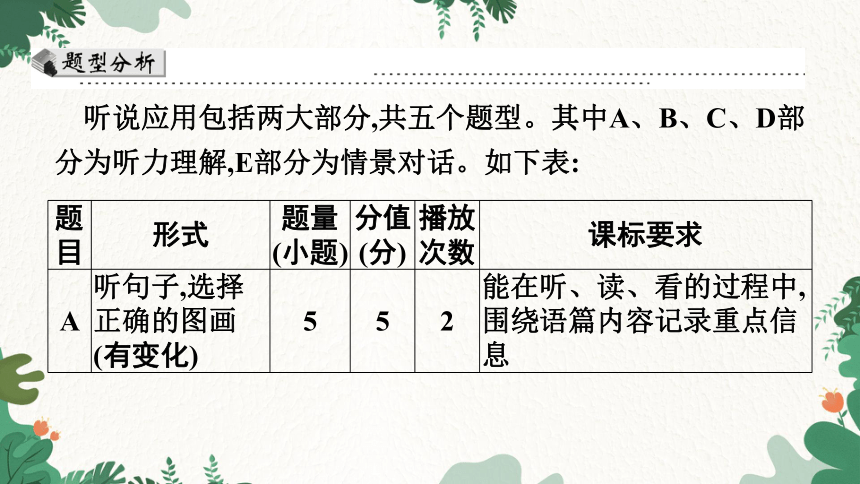
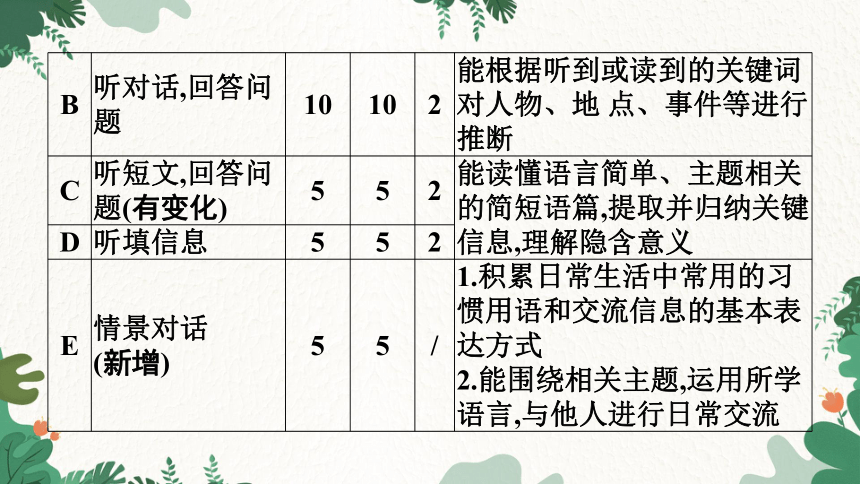
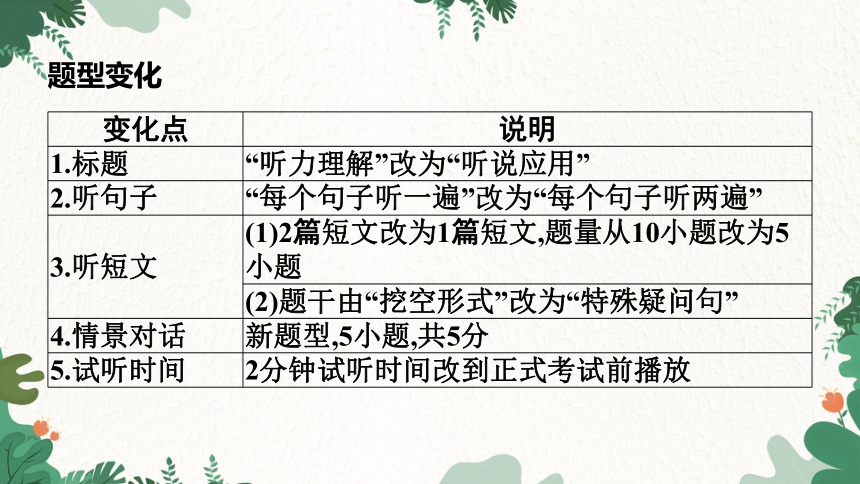
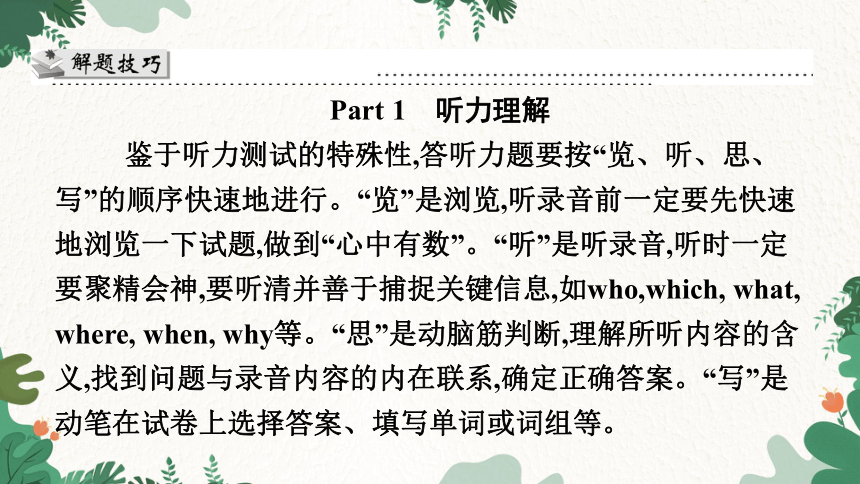
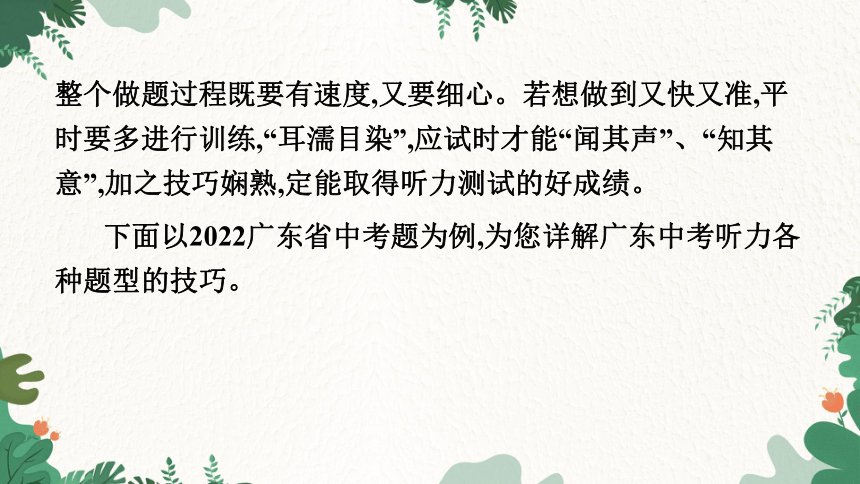


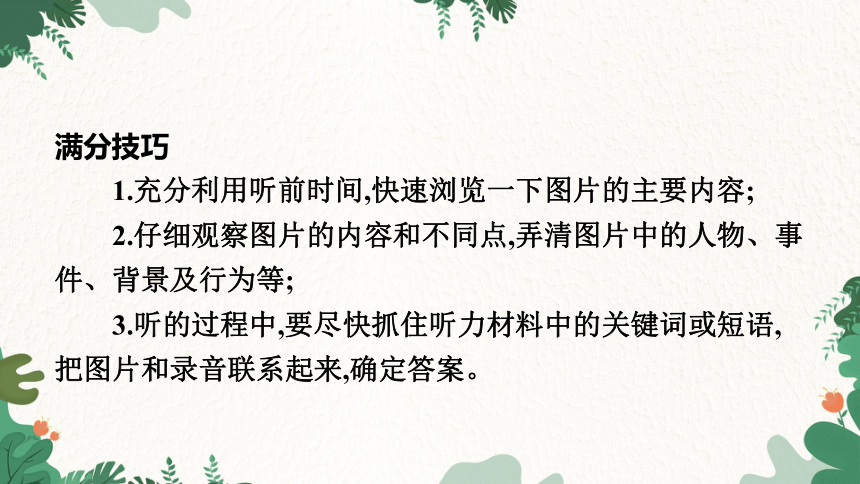
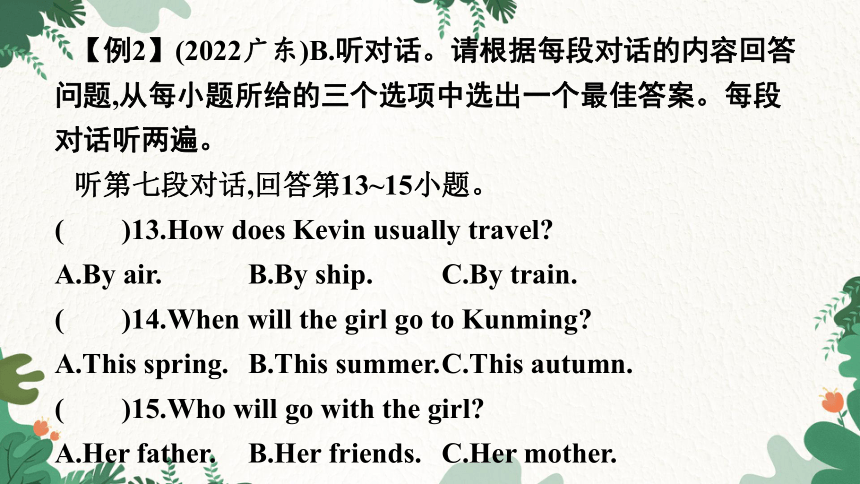
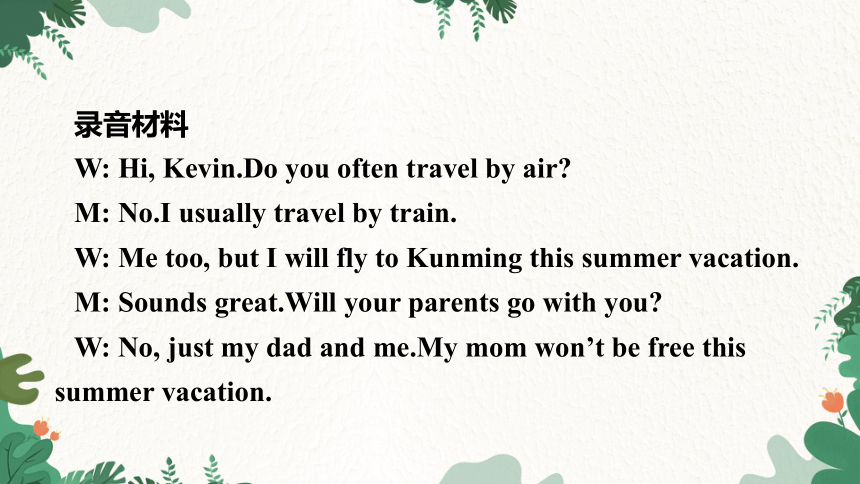
文档简介
(共65张PPT)
第一节 题型解读
01
题型分析
02
解题技巧
听说应用包括两大部分,共五个题型。其中A、B、C、D部分为听力理解,E部分为情景对话。如下表:
题目 形式 题量 (小题) 分值 (分) 播放 次数 课标要求
A 听句子,选择正确的图画(有变化) 5 5 2 能在听、读、看的过程中, 围绕语篇内容记录重点信息
B 听对话,回答问题 10 10 2 能根据听到或读到的关键词对人物、地 点、事件等进行推断
C 听短文,回答问题(有变化) 5 5 2 能读懂语言简单、主题相关的简短语篇,提取并归纳关键信息,理解隐含意义
D 听填信息 5 5 2
E 情景对话 (新增) 5 5 / 1.积累日常生活中常用的习惯用语和交流信息的基本表达方式
2.能围绕相关主题,运用所学语言,与他人进行日常交流
题型变化
变化点 说明
1.标题 “听力理解”改为“听说应用”
2.听句子 “每个句子听一遍”改为“每个句子听两遍”
3.听短文 (1)2篇短文改为1篇短文,题量从10小题改为5小题
(2)题干由“挖空形式”改为“特殊疑问句”
4.情景对话 新题型,5小题,共5分
5.试听时间 2分钟试听时间改到正式考试前播放
Part 1 听力理解
鉴于听力测试的特殊性,答听力题要按“览、听、思、写”的顺序快速地进行。“览”是浏览,听录音前一定要先快速地浏览一下试题,做到“心中有数”。“听”是听录音,听时一定要聚精会神,要听清并善于捕捉关键信息,如who,which, what, where, when, why等。“思”是动脑筋判断,理解所听内容的含义,找到问题与录音内容的内在联系,确定正确答案。“写”是动笔在试卷上选择答案、填写单词或词组等。
整个做题过程既要有速度,又要细心。若想做到又快又准,平时要多进行训练,“耳濡目染”,应试时才能“闻其声”、“知其意”,加之技巧娴熟,定能取得听力测试的好成绩。
下面以2022广东省中考题为例,为您详解广东中考听力各种题型的技巧。
【例1】(2022广东)A.听句子。请根据所听内容,选择符合题意的图画回答问题。每个句子听两遍。
( )1.What did the girl draw
A B C
录音材料
The little girl drew a picture of 2 apples.
参考答案
1.C 本题在听录音时要抓住“2 apples”这个关键短语,从三张图片中找出对应的第三幅图,故选C。
满分技巧
1.充分利用听前时间,快速浏览一下图片的主要内容;
2.仔细观察图片的内容和不同点,弄清图片中的人物、事件、背景及行为等;
3.听的过程中,要尽快抓住听力材料中的关键词或短语,把图片和录音联系起来,确定答案。
【例2】(2022广东)B.听对话。请根据每段对话的内容回答问题,从每小题所给的三个选项中选出一个最佳答案。每段对话听两遍。
听第七段对话,回答第13~15小题。
( )13.How does Kevin usually travel
A.By air. B.By ship. C.By train.
( )14.When will the girl go to Kunming
A.This spring. B.This summer. C.This autumn.
( )15.Who will go with the girl
A.Her father. B.Her friends. C.Her mother.
录音材料
W: Hi, Kevin.Do you often travel by air
M: No.I usually travel by train.
W: Me too, but I will fly to Kunming this summer vacation.
M: Sounds great.Will your parents go with you
W: No, just my dad and me.My mom won’t be free this summer vacation.
参考答案
13.C 本题要求考生回答Kevin的旅游出行方式。关键信息句是“No.I usually travel by train.”,可知关键信息是“by train”,故选C。
14.B 本题要求考生回答女孩去昆明的时间。关键信息句是“ I will fly to Kunming this summer vacation”,可知关键信息是“this summer vacation”,故选B。
15.A 本题要求考生回答陪伴女孩一起出游的人是谁。关键信息句是“No, just my dad and me.My mom won’t be free this summer vacation.” ,可知关键信息是“just my dad and me”,故选A。
满分技巧
1.听前分析、了解信息、把握话题。听录音前先快速浏览所给的书面材料,通过分析比较,可以从中得到某些信息和提示,从而预测和把握对话的话题和中心内容。
2.静听对话、捕捉信息、适当记录。在对各选项进行分析、预测了对话的主题后,要以对话人角色进入语境,静听双方所说的话。在听懂大意的同时,有的放矢地捕捉关键信息,必要时做些适当记录,以便作为判断依据。听音过程中对那些显而易见的答案要当机立断,及时作出正确选择。
3.合理推测、善于取舍、核对复查。听完对话录音后,要善于就对话中各种已知信息相互间联系进行合理推测判断,侧重于特定情景对话中的语义理解,经过分析处理,排除音、形、义上与对话内容相近的干扰项,通过合理取舍,选定正确答案。最后再对每一选定的答案进行核对复查,确保无误。
【例3】(2022广东)C.听短文。请根据所听内容,从每小题所给的三个选项中选出一个最佳答案。短文听两遍。
( )16.What did Jason’s mother do every night
A.She read him stories.
B.She made him clothes.
C.She taught him English.
( )17.What happened to Jason when he was 12
A.He got hit by a truck.
B.He dropped out of school.
C.He lost his books.
( )18.Where did Jason find some books one night
A.In a room. B.By the road. C.In a library.
( )19.How many books has Jason collected
A.About 20,000. B.About 2,000. C.About 200.
( )20.When is the small library open
A.Every evening. B.Every afternoon. C.Every weekend.
录音材料
Jason got into the habit of reading when he was a little boy.His mother used to read bedtime stories to him every night.Unluckily, at the age of 12, he dropped out of school because his family was so poor.But this never stopped him from reading.Later, Jason got a job of driving the rubbish truck.One night, he found some books left by the road.They were thrown away as rubbish.Jason felt so sad about this.He decided to save such books.
Over the years, he has collected about 20,000 books.With so many books, he turned his home into a small library for children.The library opens every weekend.Children can have a wonderful reading time there, and they all love this place.
参考答案
16.A 本题要求考生回答Jason的母亲每晚的活动。注意捕捉关键句“His mother used to read bedtime stories to him every night.”,可知答案选A。
17.B 本题要求考生回答Jason在12岁时发生的事情。注意捕捉关键句“Unluckily, at the age of 12, he dropped out of school because his family was so poor.”,可知答案选B。
18.B 本题要求考生回答Jason发现书籍的地方。注意捕捉关键句“One night, he found some books left by the road.”,可知答案选B。
19.A 本题要求考生回答Jason收集的书籍数量。注意捕捉关键句“Over the years, he has collected about 20,000 books.”,可知答案选A。
20.C 本题要求考生回答小图书馆开放的时间。注意捕捉关键句“The library opens every weekend.”,可知答案选C。
满分技巧
1.仔细审题、捕捉信息、预测内容。听录音前要充分利用间隙时间,浏览该题有关的书面材料,将捕捉到的信息通过分析、推理,推测该短文可能涉及的内容,进一步预测问题可能从哪几方面提出,这样就可做到带着问题去听录音,减少盲目性。
2.边听边记、简要记录、突破难点。在第一遍听录音时要边听边记,对关键词语做简要记录,重点记清有关时间、地点、人物、情节等具体细节,以便为答题提供依据。对于显而易见的答案可以随手作答,而对于一时难以判定的,要对包含其解题信息的有关内容予以特别关注。
3.联想推理、正确判定、复查验证。第二遍听录音时,根据对录音全文的理解,结合所记录的有关信息对各小题作出正确的判定。如果在短文中找不出直接的答案,应用联想推理的办法,通过分析比较、综合概括作出符合逻辑的选择。选定答案后还要逐题复查验证,以减少差错。
【例4】(2022广东)D.听填信息。你将听到一则设计活动的介绍。请你根据所听内容填写下面的信息卡。短文听两遍。
T-shirt Design (设计) Wanted
Topic: saving the 21
Design: a 22 and some words
Important dates: to hand in before July 21st
to get the result on August 23
Prizes: to work with the magazine next 24 holiday
to get 100 25 T-shirts for free
录音材料
Hi, everyone. I’m glad to tell you that the famous magazine Environment wants good designs of T-shirts from students in all schools like ours.The topic is about saving the panda.You’re all welcome to take part in this activity.Please make sure to put a picture and some words on the T-shirt to show that you care about the panda.Your works must be handed in before July 21st.The result will come out on August 11th.
The winners will get a chance to work with the magazine next winter holiday.The winners’ schools will get 100 green T-shirts for free.It is a good chance.If you want to join in, please get ready.Good luck to you all!
参考答案
21.panda 根据空格前面的“saving the”可知本空要求填一个名词。注意捕捉关键句“The topic is about saving the panda.”。
22.picture 根据空格前面的“a”和后面的“and some words”可知本空要求填一个名词。注意捕捉关键句“Please make sure to put a picture and some words on the T-shirt to show that you care about the panda.”。
23.11(th) 根据空格前面的“on August ”可知本空要求填一个日期(数词)。注意捕捉关键句“The result will come out on August 11th.”。
24.winter 根据空格后面的holiday可知本空应填一个名词。注意捕捉关键句“The winners will get a chance to work with the magazine next winter holiday.”。
25.green 根据空格后面的T-shirts可知本空要求填一个形容词。注意捕捉关键句“The winners’ schools will get 100 green T-shirts for free.”。
满分技巧
1.预测内容
在听录音之前,要快速浏览题干内容,特别是前面的提示内容和表格的第一行和第一列,预测对话或短文的话题,并根据表格确定要获取哪方面的信息。具体方法:先进行信息的猜测,锁定几个可能填的词,再根据所听到的录音确定要填的词。如2022年中考题的第21题,根据空格前面的“saving the”可知本空要求填一个名词。
2.信息定位
在听第一次录音时,注意信息定位。如2022年中考题的第23题,根据“on August”可推测答案与日期有关,所以,当听到有关日期的单词的时候要特别警觉!
3.学会记录
听第一遍录音时要全神贯注地边听边跟着题干内容走,当听到空格处要快速记下需填的内容。速记的技巧:时间和数量等用阿拉伯数字,人名地名用代号,单位用缩写符号,短语用首字母,有的可用中文,甚至可用只有你自己熟悉的简图或符号。如:fifty dollars记作$50; more than 28记作28+或>28; less than 17记作17-或<17;上午用a.m.;下午用p.m.,等等。
4.绝不留空
如果答案需要填两个单词,你只会其中的一个单词也一定要写上这一个;如果对答案单词的词形没有十分把握,也应填上单词原形。因为即使答案不完全准确,但若基本表达了所需要的信息,也能得分。
5.单词熟练
空格中要填的单词通常是常用词,也包括了考生易写错的单词。填完之后,要结合全句及全文分析所填单词是否正确。可从语态、时态、单复数、前后缀、大小写、主谓一致和名词所有格等方面去核对。同学们除了掌握解题技巧外,平时还应注意多积累相关必备基础知识。如:
①时间表达方式 ②学科的名称 ③表示数目的单词
④年代表达方式 ⑤日期、星期及月份 ⑥四个季节
⑦金钱的表达方式 ⑧常见地名 ⑨国家和国籍
Part 2 情景对话
【例】(2022广东)E.情景对话。请通读下面对话,根据对话内容,从方框内的选项中选出能填入空白处的最佳选项,选项中有一项为多余选项。
A.Really
B.What about you
C.Maybe next time.
D.The park near your home
E.Have a good time.
F.Would you like to go with us
Tom: What’s your plan tomorrow, Ann
Ann: I’ll stay at home. 26
Tom: I will have a picnic in a park with some friends.
Ann: 27
Tom: No.We’ll go to Zhongshan Park.
Ann: Have you checked the weather report
Tom: Yes.It’ll be sunny. 28
Ann: I’d love to, but I have to finish a school report.
Tom: What a pity! 29
Ann: OK. 30
Tom: Thank you.
参考答案
26.B 根据下句“I will have a picnic in a park with some friends.”可知Ann回答了自己明天的计划,故选B。
27.D 根据下句“No.We’ll go to Zhongshan Park.”可知此处询问与“公园”相关的信息,故选D。
28.F 根据下句“I’d love to, but I have to finish a school report.”可知上句是Tom发出邀请,故选F。
29.C 根据上句可知Ann无法赴约,故此处是Tom打算与Ann相约下次,故选C。
30.E 结合语境可知Ann虽然无法赴约,但依然希望Tom 能玩得开心,故选E。
新题型解读
“情景对话”是2022年广东中考省卷新增题型,旨在考查学生实际运用日常交际用语的能力,特别是在真实语境中沟通信息、描述事物与表达情感、发表观点和意见的能力。要求学生根据对话内容,从方框内的选项中选出能填入空白处的最佳选项,并排除其中一个多余选项。
此类题型形式贴近生活,能开拓学生的思维能力。做这种题时要面向整体内容,切忌片面理解。首先要把全篇对话通读一遍,了解对话的整体结构,把握对话的内容及语境,理解双方的谈话意图。抓住关键词进行推理,使所选的句子填入后组成的对话结构完整、合理。
满分技巧
1.熟读背诵初中英语教材中出现过的日常交际用语。如问候、介绍、问路、看病、购物、就餐、祝愿、打电话、谈天气等固定句式和习惯表达方式(详见P6“【拓展】常用情景交际用语”);
2.掌握各交际项目的习惯用法;
3.答题时要面向整体内容,切忌片面理解;
4.通过阅读中心句快速掌握文章脉络;
5.抓好关键词和指示性词汇,进行推断,使句子结构完整,合理;
6.注意对话的表达要符合西方国家的风俗习惯;
7.正确书写,从容答题。
注意:在首次阅读的过程中如果不能确定某些单句是否与该段落相匹配,最好做个记号,以便第二次阅读时更有针对性。第二次阅读的目的:一是检查已初步确定的段落与单句是否确实匹配;二是完成第一遍阅读中尚未解答的题目。
【拓展】常用情景交际用语
常见日常交际用语及情景反应主要有:问候;介绍;告别;打电话;感谢;祝愿;道歉;邀请和约会;提供帮助;请求允许;谈论天气;购物;问路;看病;劝告和建议;就餐等。以上的情景交际在汉语中也是很常见的。但中英文在思维及表达方式上差距较大。下面列出一些常用的交际用语供同学们参考,同学们在日常学习时也要注意积累。
1.表示问候
(1)一般打招呼用语,答语通常是重复对方的话。
Hello.(你好!)/Hi.(嗨!)/Good morning(afternoon/evening).早上(下午/晚上)好。
(2)您好!初次见面打招呼的用语:How do you do /Glad to meet you.
答语也是:How do you do /Glad to meet you.
(3)对有一段时间没有见面的熟人可选用这些句型:How are you /How have you been 你(您)好吗 答语往往是:“Fine, thank you.And you ”
(4)向认识但不常见面的人打招呼,可选用这些表达法:How’s everything with you /How is everything going /How are you getting on /What’s on/up 近来怎么样
答语可用:Pretty well./Very well./Everything is OK.(一切顺利。)/Not too bad.(还好。)
(5)对于不认识的人但想要叫他(她)停下来时,可选用这些说法:Hey, sir(madam).喂,先生(小姐)。/Just a moment, sir(madam).等一下,先生(小姐)。
2.看病
(1)询问病人哪儿不舒服的常用语:
What’s the matter with you
What’s the matter with your+部位(leg)
What’s wrong with you
What’s the trouble with sb.
What’s your trouble, young man Is there anything wrong with sb./sth. (him/his left hand)
(2)病人谈论病情通常为:
I don’t feel well.
I have a (bad) headache.
I have got a (bad)cough. I have got a bad cold./I have (got)a fever./I have got a pain here.
There is something wrong with my eyes. I’m not very well./I don’t feel very well./I’m not feeling very well.
I feel terrible(bad/ill).
I feel tired all the time./I feel very weak.
(3)医生安慰病人的常用语:
It’s nothing serious./Nothing serious.
You’ll be well (fine/OK)again in a few days.
You’ll be all right soon.
Don’t worry, you’ll be well soon.
3.问路与应答
问路前先道一声“Excuse me”显得比较礼貌。对方指路时,假如没有听懂,可以说:Pardon /Excuse me./Would you say it again 恳求对方说一次。
(1)问路常用语:
Excuse me,how can I get to/reach the hospital Excuse me,which is the way to the hospital
Excuse me,where is the hospital,please
Excuse me,could you tell/show me the way to the hospital
Excuse me,could you tell me how I can get to the hospital Excuse me,could you tell me how to get to the hospital
Excuse me,is there a hospital near here (Yes,there is./No,there isn’t.)
Is this the right way to the bookshop /Does this/the bus go to the bookshop
(2)询问路程有多远的用语:
How far is the hospital (from here)
How far is it from A to B
How far away is the hospital
How many metres (kilometres) is it from here to the hospital
回答一般用It’s+距离,如:
It’s only a few kilometres./It’s half an hour’s walk (from here to…)
The hospital is about half an hour’s ride by bike/by car…
(3)建议问路者乘交通工具去的常用语:
You’d better take a bus there.
What shall I take to there
Can I take a bus to get there
Which bus shall I take (to get to…)
Bus No.4 will take you to get to …
(4)问路者应该用的道谢语:
Thank you./Thanks./Thank you very much./Thanks a lot./Thank you all the same.
I’m sorry, I don’t know the way, either.You’d better go and ask the policeman over there.
I’m not sure./Sorry, I’m new here,too.
4.打电话
·想找某人听电话常用:Hello! May/Could I speak to sb.(Lucy),please I would like to speak to sb. (Lucy).
如果要找的人在附近。接电话者需要时间帮你叫来,需要你稍等一下,常会说:Hold on for a moment, please./Hold on, please.
如要找的人不在或外出了常用:Sorry, she/he isn’t here right now./I’m sorry,she/he isn’t in./I’m afraid, she/he is out.
·接电话者自我介绍常用:(不可用I am/I’m…)
This is Lucy (sb.) speaking./Lucy (sb.) speaking./Lucy here.
·接电话者询问对方是谁常用:(不可用Are you… )
Who’s that speaking /Who’s calling
·询问对方是否留言常用:Can I take a message for you Will/Would you please give a message to him
Can I take a message Can you take a message for me
5.购物
(1)购物常会以售货员向顾客打招呼为开始:What can I do for you Can/May I help you
然后顾客根据自己的实际情况做出回答:I want to buy sth. (for sb.). I am looking for sth.(a pair of shoes).
I want/would like sth. (a pair of shoes)
I’d like sth. I just have a look.
(2)售货员询问顾客要什么种类,款式,颜色,号码时常用:What size do you want
What colour do you want
What kind of clothes do you want/like
What style do you want/prefer
(3)顾客如果对当前的物品不满意,要求售货员提供其他的种类,款式,颜色,号码时常用:
Do you have any other size/colour/kind/style
Do you have any cheaper ones
Have you got a bigger size
Have you got anything a bit longer
Have you got a longer one/any longer ones
(4)询问顾客对物品的看法:How do you like this (one) What do you think of this (one)/this pair
What about/How about the colour/the size/the style
(5)顾客表达对物品的看法:I think it’s nice./It is nice. I don’t think it’s nice.
I like it/them (but)… It looks a bit large/long/short.
(6)询问价钱:How much is it/are they How much does it/do they cost What is the price of it/名词
(7)讨价:That’s much too dear/expensive.I’m afraid… They cost too much.Can they be cheaper
(8)要求试穿:Can/May I try it/them on
(9)做出决定:I will take/buy/get it. I can’t decide.I must think about it.
(10)售货员询问顾客是否还要其他物品时常用:Is there anything else I can do for you Anything else
What else would you like Is that all
6.祝愿、祝贺及应答
(1)当某人取得成功时
A:I have passed the examination!
B:Congratulations (to you)!
(2)当某人外出旅行时
Good luck with your trip! Have a good trip/journey.=I wish you a good trip/journey. Good trip to you./Nice journey to you. Have a nice/pleasant/wonderful time.=I wish you a nice/pleasant/wonderful time.
(3)当某人生日时
A: Happy birthday to you! B: Thank you!
(4)当某人即将做某事时
A:I will take the exams tomorrow.
B: Good luck (to you)!(I wish you success!)
注:上述几点中祝愿(贺)的回答可用:Thanks./Thank you./Thanks a lot.或It’s kind of you to say so.
(5)在公共节日里
A: Happy New Year (to you)!
B: Thanks.The same to you!(Happy New Year to you, too!)
(说明:由于本书篇幅有限不能展示更多交际用语,同学们可以登录www.pinxuejy.com免费下载更多常用的交际用语的电子文档,交际用语在听力及口语中也会考查,积累常用的交际用语是非常重要的。)
第一节 题型解读
01
题型分析
02
解题技巧
听说应用包括两大部分,共五个题型。其中A、B、C、D部分为听力理解,E部分为情景对话。如下表:
题目 形式 题量 (小题) 分值 (分) 播放 次数 课标要求
A 听句子,选择正确的图画(有变化) 5 5 2 能在听、读、看的过程中, 围绕语篇内容记录重点信息
B 听对话,回答问题 10 10 2 能根据听到或读到的关键词对人物、地 点、事件等进行推断
C 听短文,回答问题(有变化) 5 5 2 能读懂语言简单、主题相关的简短语篇,提取并归纳关键信息,理解隐含意义
D 听填信息 5 5 2
E 情景对话 (新增) 5 5 / 1.积累日常生活中常用的习惯用语和交流信息的基本表达方式
2.能围绕相关主题,运用所学语言,与他人进行日常交流
题型变化
变化点 说明
1.标题 “听力理解”改为“听说应用”
2.听句子 “每个句子听一遍”改为“每个句子听两遍”
3.听短文 (1)2篇短文改为1篇短文,题量从10小题改为5小题
(2)题干由“挖空形式”改为“特殊疑问句”
4.情景对话 新题型,5小题,共5分
5.试听时间 2分钟试听时间改到正式考试前播放
Part 1 听力理解
鉴于听力测试的特殊性,答听力题要按“览、听、思、写”的顺序快速地进行。“览”是浏览,听录音前一定要先快速地浏览一下试题,做到“心中有数”。“听”是听录音,听时一定要聚精会神,要听清并善于捕捉关键信息,如who,which, what, where, when, why等。“思”是动脑筋判断,理解所听内容的含义,找到问题与录音内容的内在联系,确定正确答案。“写”是动笔在试卷上选择答案、填写单词或词组等。
整个做题过程既要有速度,又要细心。若想做到又快又准,平时要多进行训练,“耳濡目染”,应试时才能“闻其声”、“知其意”,加之技巧娴熟,定能取得听力测试的好成绩。
下面以2022广东省中考题为例,为您详解广东中考听力各种题型的技巧。
【例1】(2022广东)A.听句子。请根据所听内容,选择符合题意的图画回答问题。每个句子听两遍。
( )1.What did the girl draw
A B C
录音材料
The little girl drew a picture of 2 apples.
参考答案
1.C 本题在听录音时要抓住“2 apples”这个关键短语,从三张图片中找出对应的第三幅图,故选C。
满分技巧
1.充分利用听前时间,快速浏览一下图片的主要内容;
2.仔细观察图片的内容和不同点,弄清图片中的人物、事件、背景及行为等;
3.听的过程中,要尽快抓住听力材料中的关键词或短语,把图片和录音联系起来,确定答案。
【例2】(2022广东)B.听对话。请根据每段对话的内容回答问题,从每小题所给的三个选项中选出一个最佳答案。每段对话听两遍。
听第七段对话,回答第13~15小题。
( )13.How does Kevin usually travel
A.By air. B.By ship. C.By train.
( )14.When will the girl go to Kunming
A.This spring. B.This summer. C.This autumn.
( )15.Who will go with the girl
A.Her father. B.Her friends. C.Her mother.
录音材料
W: Hi, Kevin.Do you often travel by air
M: No.I usually travel by train.
W: Me too, but I will fly to Kunming this summer vacation.
M: Sounds great.Will your parents go with you
W: No, just my dad and me.My mom won’t be free this summer vacation.
参考答案
13.C 本题要求考生回答Kevin的旅游出行方式。关键信息句是“No.I usually travel by train.”,可知关键信息是“by train”,故选C。
14.B 本题要求考生回答女孩去昆明的时间。关键信息句是“ I will fly to Kunming this summer vacation”,可知关键信息是“this summer vacation”,故选B。
15.A 本题要求考生回答陪伴女孩一起出游的人是谁。关键信息句是“No, just my dad and me.My mom won’t be free this summer vacation.” ,可知关键信息是“just my dad and me”,故选A。
满分技巧
1.听前分析、了解信息、把握话题。听录音前先快速浏览所给的书面材料,通过分析比较,可以从中得到某些信息和提示,从而预测和把握对话的话题和中心内容。
2.静听对话、捕捉信息、适当记录。在对各选项进行分析、预测了对话的主题后,要以对话人角色进入语境,静听双方所说的话。在听懂大意的同时,有的放矢地捕捉关键信息,必要时做些适当记录,以便作为判断依据。听音过程中对那些显而易见的答案要当机立断,及时作出正确选择。
3.合理推测、善于取舍、核对复查。听完对话录音后,要善于就对话中各种已知信息相互间联系进行合理推测判断,侧重于特定情景对话中的语义理解,经过分析处理,排除音、形、义上与对话内容相近的干扰项,通过合理取舍,选定正确答案。最后再对每一选定的答案进行核对复查,确保无误。
【例3】(2022广东)C.听短文。请根据所听内容,从每小题所给的三个选项中选出一个最佳答案。短文听两遍。
( )16.What did Jason’s mother do every night
A.She read him stories.
B.She made him clothes.
C.She taught him English.
( )17.What happened to Jason when he was 12
A.He got hit by a truck.
B.He dropped out of school.
C.He lost his books.
( )18.Where did Jason find some books one night
A.In a room. B.By the road. C.In a library.
( )19.How many books has Jason collected
A.About 20,000. B.About 2,000. C.About 200.
( )20.When is the small library open
A.Every evening. B.Every afternoon. C.Every weekend.
录音材料
Jason got into the habit of reading when he was a little boy.His mother used to read bedtime stories to him every night.Unluckily, at the age of 12, he dropped out of school because his family was so poor.But this never stopped him from reading.Later, Jason got a job of driving the rubbish truck.One night, he found some books left by the road.They were thrown away as rubbish.Jason felt so sad about this.He decided to save such books.
Over the years, he has collected about 20,000 books.With so many books, he turned his home into a small library for children.The library opens every weekend.Children can have a wonderful reading time there, and they all love this place.
参考答案
16.A 本题要求考生回答Jason的母亲每晚的活动。注意捕捉关键句“His mother used to read bedtime stories to him every night.”,可知答案选A。
17.B 本题要求考生回答Jason在12岁时发生的事情。注意捕捉关键句“Unluckily, at the age of 12, he dropped out of school because his family was so poor.”,可知答案选B。
18.B 本题要求考生回答Jason发现书籍的地方。注意捕捉关键句“One night, he found some books left by the road.”,可知答案选B。
19.A 本题要求考生回答Jason收集的书籍数量。注意捕捉关键句“Over the years, he has collected about 20,000 books.”,可知答案选A。
20.C 本题要求考生回答小图书馆开放的时间。注意捕捉关键句“The library opens every weekend.”,可知答案选C。
满分技巧
1.仔细审题、捕捉信息、预测内容。听录音前要充分利用间隙时间,浏览该题有关的书面材料,将捕捉到的信息通过分析、推理,推测该短文可能涉及的内容,进一步预测问题可能从哪几方面提出,这样就可做到带着问题去听录音,减少盲目性。
2.边听边记、简要记录、突破难点。在第一遍听录音时要边听边记,对关键词语做简要记录,重点记清有关时间、地点、人物、情节等具体细节,以便为答题提供依据。对于显而易见的答案可以随手作答,而对于一时难以判定的,要对包含其解题信息的有关内容予以特别关注。
3.联想推理、正确判定、复查验证。第二遍听录音时,根据对录音全文的理解,结合所记录的有关信息对各小题作出正确的判定。如果在短文中找不出直接的答案,应用联想推理的办法,通过分析比较、综合概括作出符合逻辑的选择。选定答案后还要逐题复查验证,以减少差错。
【例4】(2022广东)D.听填信息。你将听到一则设计活动的介绍。请你根据所听内容填写下面的信息卡。短文听两遍。
T-shirt Design (设计) Wanted
Topic: saving the 21
Design: a 22 and some words
Important dates: to hand in before July 21st
to get the result on August 23
Prizes: to work with the magazine next 24 holiday
to get 100 25 T-shirts for free
录音材料
Hi, everyone. I’m glad to tell you that the famous magazine Environment wants good designs of T-shirts from students in all schools like ours.The topic is about saving the panda.You’re all welcome to take part in this activity.Please make sure to put a picture and some words on the T-shirt to show that you care about the panda.Your works must be handed in before July 21st.The result will come out on August 11th.
The winners will get a chance to work with the magazine next winter holiday.The winners’ schools will get 100 green T-shirts for free.It is a good chance.If you want to join in, please get ready.Good luck to you all!
参考答案
21.panda 根据空格前面的“saving the”可知本空要求填一个名词。注意捕捉关键句“The topic is about saving the panda.”。
22.picture 根据空格前面的“a”和后面的“and some words”可知本空要求填一个名词。注意捕捉关键句“Please make sure to put a picture and some words on the T-shirt to show that you care about the panda.”。
23.11(th) 根据空格前面的“on August ”可知本空要求填一个日期(数词)。注意捕捉关键句“The result will come out on August 11th.”。
24.winter 根据空格后面的holiday可知本空应填一个名词。注意捕捉关键句“The winners will get a chance to work with the magazine next winter holiday.”。
25.green 根据空格后面的T-shirts可知本空要求填一个形容词。注意捕捉关键句“The winners’ schools will get 100 green T-shirts for free.”。
满分技巧
1.预测内容
在听录音之前,要快速浏览题干内容,特别是前面的提示内容和表格的第一行和第一列,预测对话或短文的话题,并根据表格确定要获取哪方面的信息。具体方法:先进行信息的猜测,锁定几个可能填的词,再根据所听到的录音确定要填的词。如2022年中考题的第21题,根据空格前面的“saving the”可知本空要求填一个名词。
2.信息定位
在听第一次录音时,注意信息定位。如2022年中考题的第23题,根据“on August”可推测答案与日期有关,所以,当听到有关日期的单词的时候要特别警觉!
3.学会记录
听第一遍录音时要全神贯注地边听边跟着题干内容走,当听到空格处要快速记下需填的内容。速记的技巧:时间和数量等用阿拉伯数字,人名地名用代号,单位用缩写符号,短语用首字母,有的可用中文,甚至可用只有你自己熟悉的简图或符号。如:fifty dollars记作$50; more than 28记作28+或>28; less than 17记作17-或<17;上午用a.m.;下午用p.m.,等等。
4.绝不留空
如果答案需要填两个单词,你只会其中的一个单词也一定要写上这一个;如果对答案单词的词形没有十分把握,也应填上单词原形。因为即使答案不完全准确,但若基本表达了所需要的信息,也能得分。
5.单词熟练
空格中要填的单词通常是常用词,也包括了考生易写错的单词。填完之后,要结合全句及全文分析所填单词是否正确。可从语态、时态、单复数、前后缀、大小写、主谓一致和名词所有格等方面去核对。同学们除了掌握解题技巧外,平时还应注意多积累相关必备基础知识。如:
①时间表达方式 ②学科的名称 ③表示数目的单词
④年代表达方式 ⑤日期、星期及月份 ⑥四个季节
⑦金钱的表达方式 ⑧常见地名 ⑨国家和国籍
Part 2 情景对话
【例】(2022广东)E.情景对话。请通读下面对话,根据对话内容,从方框内的选项中选出能填入空白处的最佳选项,选项中有一项为多余选项。
A.Really
B.What about you
C.Maybe next time.
D.The park near your home
E.Have a good time.
F.Would you like to go with us
Tom: What’s your plan tomorrow, Ann
Ann: I’ll stay at home. 26
Tom: I will have a picnic in a park with some friends.
Ann: 27
Tom: No.We’ll go to Zhongshan Park.
Ann: Have you checked the weather report
Tom: Yes.It’ll be sunny. 28
Ann: I’d love to, but I have to finish a school report.
Tom: What a pity! 29
Ann: OK. 30
Tom: Thank you.
参考答案
26.B 根据下句“I will have a picnic in a park with some friends.”可知Ann回答了自己明天的计划,故选B。
27.D 根据下句“No.We’ll go to Zhongshan Park.”可知此处询问与“公园”相关的信息,故选D。
28.F 根据下句“I’d love to, but I have to finish a school report.”可知上句是Tom发出邀请,故选F。
29.C 根据上句可知Ann无法赴约,故此处是Tom打算与Ann相约下次,故选C。
30.E 结合语境可知Ann虽然无法赴约,但依然希望Tom 能玩得开心,故选E。
新题型解读
“情景对话”是2022年广东中考省卷新增题型,旨在考查学生实际运用日常交际用语的能力,特别是在真实语境中沟通信息、描述事物与表达情感、发表观点和意见的能力。要求学生根据对话内容,从方框内的选项中选出能填入空白处的最佳选项,并排除其中一个多余选项。
此类题型形式贴近生活,能开拓学生的思维能力。做这种题时要面向整体内容,切忌片面理解。首先要把全篇对话通读一遍,了解对话的整体结构,把握对话的内容及语境,理解双方的谈话意图。抓住关键词进行推理,使所选的句子填入后组成的对话结构完整、合理。
满分技巧
1.熟读背诵初中英语教材中出现过的日常交际用语。如问候、介绍、问路、看病、购物、就餐、祝愿、打电话、谈天气等固定句式和习惯表达方式(详见P6“【拓展】常用情景交际用语”);
2.掌握各交际项目的习惯用法;
3.答题时要面向整体内容,切忌片面理解;
4.通过阅读中心句快速掌握文章脉络;
5.抓好关键词和指示性词汇,进行推断,使句子结构完整,合理;
6.注意对话的表达要符合西方国家的风俗习惯;
7.正确书写,从容答题。
注意:在首次阅读的过程中如果不能确定某些单句是否与该段落相匹配,最好做个记号,以便第二次阅读时更有针对性。第二次阅读的目的:一是检查已初步确定的段落与单句是否确实匹配;二是完成第一遍阅读中尚未解答的题目。
【拓展】常用情景交际用语
常见日常交际用语及情景反应主要有:问候;介绍;告别;打电话;感谢;祝愿;道歉;邀请和约会;提供帮助;请求允许;谈论天气;购物;问路;看病;劝告和建议;就餐等。以上的情景交际在汉语中也是很常见的。但中英文在思维及表达方式上差距较大。下面列出一些常用的交际用语供同学们参考,同学们在日常学习时也要注意积累。
1.表示问候
(1)一般打招呼用语,答语通常是重复对方的话。
Hello.(你好!)/Hi.(嗨!)/Good morning(afternoon/evening).早上(下午/晚上)好。
(2)您好!初次见面打招呼的用语:How do you do /Glad to meet you.
答语也是:How do you do /Glad to meet you.
(3)对有一段时间没有见面的熟人可选用这些句型:How are you /How have you been 你(您)好吗 答语往往是:“Fine, thank you.And you ”
(4)向认识但不常见面的人打招呼,可选用这些表达法:How’s everything with you /How is everything going /How are you getting on /What’s on/up 近来怎么样
答语可用:Pretty well./Very well./Everything is OK.(一切顺利。)/Not too bad.(还好。)
(5)对于不认识的人但想要叫他(她)停下来时,可选用这些说法:Hey, sir(madam).喂,先生(小姐)。/Just a moment, sir(madam).等一下,先生(小姐)。
2.看病
(1)询问病人哪儿不舒服的常用语:
What’s the matter with you
What’s the matter with your+部位(leg)
What’s wrong with you
What’s the trouble with sb.
What’s your trouble, young man Is there anything wrong with sb./sth. (him/his left hand)
(2)病人谈论病情通常为:
I don’t feel well.
I have a (bad) headache.
I have got a (bad)cough. I have got a bad cold./I have (got)a fever./I have got a pain here.
There is something wrong with my eyes. I’m not very well./I don’t feel very well./I’m not feeling very well.
I feel terrible(bad/ill).
I feel tired all the time./I feel very weak.
(3)医生安慰病人的常用语:
It’s nothing serious./Nothing serious.
You’ll be well (fine/OK)again in a few days.
You’ll be all right soon.
Don’t worry, you’ll be well soon.
3.问路与应答
问路前先道一声“Excuse me”显得比较礼貌。对方指路时,假如没有听懂,可以说:Pardon /Excuse me./Would you say it again 恳求对方说一次。
(1)问路常用语:
Excuse me,how can I get to/reach the hospital Excuse me,which is the way to the hospital
Excuse me,where is the hospital,please
Excuse me,could you tell/show me the way to the hospital
Excuse me,could you tell me how I can get to the hospital Excuse me,could you tell me how to get to the hospital
Excuse me,is there a hospital near here (Yes,there is./No,there isn’t.)
Is this the right way to the bookshop /Does this/the bus go to the bookshop
(2)询问路程有多远的用语:
How far is the hospital (from here)
How far is it from A to B
How far away is the hospital
How many metres (kilometres) is it from here to the hospital
回答一般用It’s+距离,如:
It’s only a few kilometres./It’s half an hour’s walk (from here to…)
The hospital is about half an hour’s ride by bike/by car…
(3)建议问路者乘交通工具去的常用语:
You’d better take a bus there.
What shall I take to there
Can I take a bus to get there
Which bus shall I take (to get to…)
Bus No.4 will take you to get to …
(4)问路者应该用的道谢语:
Thank you./Thanks./Thank you very much./Thanks a lot./Thank you all the same.
I’m sorry, I don’t know the way, either.You’d better go and ask the policeman over there.
I’m not sure./Sorry, I’m new here,too.
4.打电话
·想找某人听电话常用:Hello! May/Could I speak to sb.(Lucy),please I would like to speak to sb. (Lucy).
如果要找的人在附近。接电话者需要时间帮你叫来,需要你稍等一下,常会说:Hold on for a moment, please./Hold on, please.
如要找的人不在或外出了常用:Sorry, she/he isn’t here right now./I’m sorry,she/he isn’t in./I’m afraid, she/he is out.
·接电话者自我介绍常用:(不可用I am/I’m…)
This is Lucy (sb.) speaking./Lucy (sb.) speaking./Lucy here.
·接电话者询问对方是谁常用:(不可用Are you… )
Who’s that speaking /Who’s calling
·询问对方是否留言常用:Can I take a message for you Will/Would you please give a message to him
Can I take a message Can you take a message for me
5.购物
(1)购物常会以售货员向顾客打招呼为开始:What can I do for you Can/May I help you
然后顾客根据自己的实际情况做出回答:I want to buy sth. (for sb.). I am looking for sth.(a pair of shoes).
I want/would like sth. (a pair of shoes)
I’d like sth. I just have a look.
(2)售货员询问顾客要什么种类,款式,颜色,号码时常用:What size do you want
What colour do you want
What kind of clothes do you want/like
What style do you want/prefer
(3)顾客如果对当前的物品不满意,要求售货员提供其他的种类,款式,颜色,号码时常用:
Do you have any other size/colour/kind/style
Do you have any cheaper ones
Have you got a bigger size
Have you got anything a bit longer
Have you got a longer one/any longer ones
(4)询问顾客对物品的看法:How do you like this (one) What do you think of this (one)/this pair
What about/How about the colour/the size/the style
(5)顾客表达对物品的看法:I think it’s nice./It is nice. I don’t think it’s nice.
I like it/them (but)… It looks a bit large/long/short.
(6)询问价钱:How much is it/are they How much does it/do they cost What is the price of it/名词
(7)讨价:That’s much too dear/expensive.I’m afraid… They cost too much.Can they be cheaper
(8)要求试穿:Can/May I try it/them on
(9)做出决定:I will take/buy/get it. I can’t decide.I must think about it.
(10)售货员询问顾客是否还要其他物品时常用:Is there anything else I can do for you Anything else
What else would you like Is that all
6.祝愿、祝贺及应答
(1)当某人取得成功时
A:I have passed the examination!
B:Congratulations (to you)!
(2)当某人外出旅行时
Good luck with your trip! Have a good trip/journey.=I wish you a good trip/journey. Good trip to you./Nice journey to you. Have a nice/pleasant/wonderful time.=I wish you a nice/pleasant/wonderful time.
(3)当某人生日时
A: Happy birthday to you! B: Thank you!
(4)当某人即将做某事时
A:I will take the exams tomorrow.
B: Good luck (to you)!(I wish you success!)
注:上述几点中祝愿(贺)的回答可用:Thanks./Thank you./Thanks a lot.或It’s kind of you to say so.
(5)在公共节日里
A: Happy New Year (to you)!
B: Thanks.The same to you!(Happy New Year to you, too!)
(说明:由于本书篇幅有限不能展示更多交际用语,同学们可以登录www.pinxuejy.com免费下载更多常用的交际用语的电子文档,交际用语在听力及口语中也会考查,积累常用的交际用语是非常重要的。)
同课章节目录
